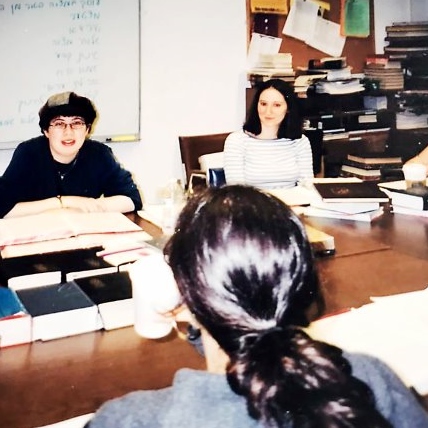click to dowload our latest edition
CLICK HERE TO SUBSCRIBE TO OUR NEWSLETTER


Published
6 years agoon
By
adminADINA ROTH
How did we get to this point, and what is the significance of women studying Talmud?
With our flourishing Jewish schools here in South Africa, it is hard to imagine that just over 100 years ago there was no formalised Jewish learning for girls. It took a visionary woman, Sarah Schenirer, to change this.
In the early 1900s, Schenirer saw that with the advent of modernity, Jewish girls were going to enter the world of work and engage in all types of secular learning. Concerned that their Jewish identities would become diluted, she advocated for Jewish learning for women.
My grandfather, Louis Oskowitz, was in Eastern Europe at the time that this debate raged. He told me that when the famed rabbinic assembly debated about whether Schenirer’s proposal for Jewish learning for girls should go forward, she was asked to wait outside the room. After the discussion, she was invited in and given a standing ovation!
Her efforts led to the founding of the Bais Yaakov schools for girls. These schools outlined a Jewish curriculum for girls that included studying the Bible and aspects of halacha deemed relevant for women.
Schenirer received halachic endorsement from the famous Rabbi Yisrael Meir Hacohen, the Chofetz Chaim. His support has subsequently come to be interpreted that women today are obligated to study Torah.
Importantly, in the Bais Yaakov schools and the other Jewish schools for women that followed, women would not study Mishnah and Talmud, the Jewish oral tradition. For most of the 20th century, women’s Jewish learning thrived in the realms of Bible, Jewish commentaries and certain halachic works.
But women were not exposed to what is regarded as the more rigorous and halachically influential aspects of Jewish learning: the Talmud. The 1983 movie, Yentl, based on a short story by Isaac Bashevis Singer, points to this split as young Yentl is taught Talmud secretly by her father in a world where open Talmudic study for girls simply isn’t possible. While the movie is set in pre-war Eastern Europe, Talmud study remained sequestered in the world of men well into the second half of the 20th century.
Jewish learning flourished for young school girls and teaching seminaries started to open for women, including the famed Jerusalem College for Women called Michlalah. It was only in 1976 that Rabbi Chaim Brovender founded the Bruriah Beit Midrash, where women could study Talmud in Jerusalem. Since then, many more places in Israel and America teach women advanced-level Talmud.
Indeed, at the Drisha Institute for Jewish Education in New York, women are given a stipend to sit and learn Talmud – much like in the traditional male yeshiva – and there are midrashot with similar practices in Israel.
I was fortunate to spend a year studying full time at the Drisha Institute and would recommend this to other Jewish women in our community who are interested in furthering their studies. With women’s increased knowledge, new professional options have opened for them.
Women have become rabbinical court advocates and halachic advisers – and also, more recently and perhaps more controversially, women are being ordained within Orthodoxy. Yeshivat Maharat in New York puts Orthodox women through a rigorous training programme which includes mastery of Talmud, halacha, Tanach and pastoral counselling, and offers women semicha at the end of their studies.
This revolution in Jewish women’s learning has many implications. Some argue that as women bring their world view to the world of Jewish text, women’s sensibilities will have an influence on interpretation. Others say that women bring positive outside influences to Jewish texts such as academic and literary sources, so that Torah learning is greatly enriched. And others say that women bring a moral, emotional or relational aspect to Torah study, heretofore not the dominant mode of Torah inquiry.
In the world of halachic interpretation, there are more and more instances where women halachic advisers are able to understand some of the sensitivities women face around the laws of menstrual purity, for example. They are therefore able to influence some of the halachic rulings in ways which are more “women-centric” while still within the bounds of Jewish law.
In expanding the options for women’s Torah study, and in sending the message to women that their learning is valued, the result has been positive, with a surge in response from Jewish women. Young girls in high school can envision careers for themselves within the Jewish community as educators, halachic advisers and spiritual leaders.
Our best and brightest don’t only need to turn to medicine and law, they can turn to the Talmud and Bible. They are “in the arena” and no longer peering from the outside, as it were, through a window.
This brings us back to South Africa, where we have a strong and rich variety of Jewish schools. Yet unlike other Jewish schools around the world, there is not one Jewish school in South Africa where girls study Talmud or are even introduced to its logic and language.
On some of our one-year post-matric programmes, particularly in Bnei Akiva, young women are exposed to Talmud study. But is it not time that we made Talmud learning available to girls in our high schools? Surely their learning would be enriching for themselves and also for our communities as a whole.
May 13 is International Women’s Talmud Day, hence our one-hour celebration of women’s Talmud learning here in Johannesburg, from 6pm to 7pm. We will study the subject, A Talmudic Perspective on Relationships. No prior Talmud learning is necessary. For more information, email Nina Cohen at nina@cohengarson.co.za.
